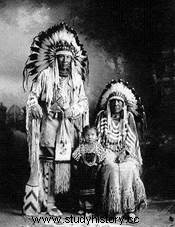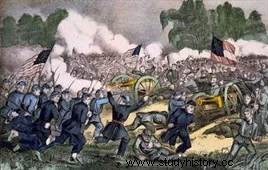 True national myth in the United States, the conquest of the West American begins at the beginning of the 19th century. After gaining their independence, the American colonists attempt to reach the Pacific Ocean, considering it to be their "Manifest Destiny". The immense territories located beyond the eastern coast allow the settlement of millions of European immigrants in search of fortune and a better life. But for the white settlers to settle, the indigenous populations of Indians will be expelled, deported, massacred, in defiance of the founding principles of the United States .
True national myth in the United States, the conquest of the West American begins at the beginning of the 19th century. After gaining their independence, the American colonists attempt to reach the Pacific Ocean, considering it to be their "Manifest Destiny". The immense territories located beyond the eastern coast allow the settlement of millions of European immigrants in search of fortune and a better life. But for the white settlers to settle, the indigenous populations of Indians will be expelled, deported, massacred, in defiance of the founding principles of the United States .
Conquest of the West and Indian tragedy
Territorial expansion of the United States and the conquest of the West began with the purchase of Louisiana from France in 1805 under the presidency of Thomas Jefferson and of Florida from Spain in 1819. Texas in turn joined the Union in 1845, after being freed from Mexico; the rest of the southwest, including California, was taken back from Mexico during the Mexican American War of 1846-1848 (Treaty of Guadalupe Hidalgo) or obtained by the Gadsden Purchase in 1853. In 1846, the course of the border with Canada, at the 49th parallel, includes the territory of Oregon; Alaska was then bought from Russia for more than 7 million dollars in 1867.
 Before colonization, North America was very sparsely populated:one million Indians divided into a myriad of tribes, which will not weigh heavily against the European thrust. White Americans indeed regard their expansion across the continent as their "manifest destiny". To settle, settlers expelled Native American tribes from their land. In 1830, the American government passed the Indian Removal Act, a law that forced the Cherokee, Creek and Seminole nations to leave the Southeast for Indian Territory located west of the Mississippi. Thousands of Indians perished during this journey, soon nicknamed "the trail of tears".
Before colonization, North America was very sparsely populated:one million Indians divided into a myriad of tribes, which will not weigh heavily against the European thrust. White Americans indeed regard their expansion across the continent as their "manifest destiny". To settle, settlers expelled Native American tribes from their land. In 1830, the American government passed the Indian Removal Act, a law that forced the Cherokee, Creek and Seminole nations to leave the Southeast for Indian Territory located west of the Mississippi. Thousands of Indians perished during this journey, soon nicknamed "the trail of tears".
As more and more farmers came to settle on the prairies, semi-nomadic peoples like the Sioux and the Métis tribes of Manitoba, Canada, were forced to leave their land. The construction of the transcontinental railway line accelerates the Indian genocide by promoting colonization in the west. We don't even respect the reserves, lands exclusively devolved to the Indians by government decree. From 1830, entire sections of Indian territory were opened to settlers. In 1874, the arrival of prospectors on the Black Hills Sioux reservation in Dakota met with fierce resistance; the American cavalry sent to protect the gold diggers was completely defeated by the Sioux and the Cheyenne at the Battle of Little Bighorn.
Sioux chiefs Sitting Bull and Crazy Horse are hunted down and eventually forced to surrender, ending the Indian Wars. In New Mexico and Arizona, the Apache leader Geronimo led a guerrilla war until 1886. Despairing of the annihilation of their way of life , many Indians join the cult of the “dance of the spirits” which promises them freedom from white law. An infamous tragedy unfolds at Wounded Knee, South Dakota, with the massacre of over 200 Sioux or "dancers" by American troops. The same year, in 1890, the western border was officially abolished, and there were barely 200,000 Indians left in North America. The west has been conquered, but at what cost?
The Gold Rush
On January 24, 1848, settler James Wilson Marshall discovered gold in a stream near the future town of Fort Sutter (California). The news spread quickly, especially as the message of the President of the United States, James Polk, - in which he evokes the existence of incalculable wealth in California (December 1848) - exacerbated the gold fever.
 By land or sea (around Cape Horn), about 100,000 people — mostly single men in from the American East, but also immigrants from Europe, Asia and Latin America — travel to California in order to make their fortune as quickly as possible. As a result of poor shelter, undernourishment and lack of medicine, nearly 10,000 people died of dysentery and other epidemics in the first year. In the mining camps with revealing names like “the territory of Hell” or “the city of the Hanged”, the men live in summary conditions, under the reign of the law of the strongest; also, to cope with the high crime rate, the mining camps are gradually being regulated.
By land or sea (around Cape Horn), about 100,000 people — mostly single men in from the American East, but also immigrants from Europe, Asia and Latin America — travel to California in order to make their fortune as quickly as possible. As a result of poor shelter, undernourishment and lack of medicine, nearly 10,000 people died of dysentery and other epidemics in the first year. In the mining camps with revealing names like “the territory of Hell” or “the city of the Hanged”, the men live in summary conditions, under the reign of the law of the strongest; also, to cope with the high crime rate, the mining camps are gradually being regulated.
In the 1860s, other gold rushes took place after the discovery of veins in Colorado (1858), Idaho (1861-1864) and the Montana (1863). On the outskirts of the gold-bearing zones, “mushroom” towns are created which, once the site has been exploited, are deserted for another valley:vestiges of this past rush, “ghost towns” then dot the American West of the 19th century. century.
The parenthesis of the Civil War
The fathers of the American constitution dreamed of freedom, but not everyone had the same vision of it depending on the color of the skin, and the question of freedom. 'slavery would divide the nation. Towards the middle of the 19th century, the number of African-American slaves, deprived of the most basic rights, rose to some 4 million individuals. The planters of the South are worried:the election as president of Abraham Lincoln, an abolitionist who wants to prevent the extension of slavery in the new territories of the West, is for them the first step towards abolition in the whole Union. The problem of slavery revives the debate on the federal government's right to interfere in the jurisdiction of the States.
 In 1861, the Civil War bursts. Early on, the Confederacy won several victories, but following the Battles of Gettysburg and Vicksburg in 1863, the conflict soon turned in favor of the Union Army of the Union. The South, weakened by famine and a shortage of vital resources, had to lay down its arms in April 1865. Just five days after winning his fight to preserve the Union and abolish slavery, Lincoln was assassinated.
In 1861, the Civil War bursts. Early on, the Confederacy won several victories, but following the Battles of Gettysburg and Vicksburg in 1863, the conflict soon turned in favor of the Union Army of the Union. The South, weakened by famine and a shortage of vital resources, had to lay down its arms in April 1865. Just five days after winning his fight to preserve the Union and abolish slavery, Lincoln was assassinated.
The North emerges from the war with almighty industry and trade . By contrast, the rural economy of the South is ruined, and it will take decades to recover. In 1868, the former slaves obtained their American citizenship and a year later the right to vote; however, black Americans are still persecuted primarily in the South. Many of them will emigrate to the cities of the North in search of work.
Conquest of the West and economic growth
The railway plays a key role in economic expansion of North America. It connects farms to large shopping centers, allows the exploitation of mineral deposits and accelerates the distribution of manufactured products. The first transcontinental line was completed in 1869. In the United States as in Canada, expansion was stimulated by the gold rush in the west.
 The United States attracts those who flee political or religious repression, want freedom, find stable work and access to education. In the middle of the 19th century, a first wave of massive immigration waves from Ireland, Great Britain and Germany; later, Scandinavians, Italians, Eastern Europeans and Asians will join them. The living and working conditions were harsh and the conflicts ended up leading to the great strike of 1877. In 1910, the United States had some 90 million inhabitants, or 50 times more than in 1776 and constituted the very first global industrial power.
The United States attracts those who flee political or religious repression, want freedom, find stable work and access to education. In the middle of the 19th century, a first wave of massive immigration waves from Ireland, Great Britain and Germany; later, Scandinavians, Italians, Eastern Europeans and Asians will join them. The living and working conditions were harsh and the conflicts ended up leading to the great strike of 1877. In 1910, the United States had some 90 million inhabitants, or 50 times more than in 1776 and constituted the very first global industrial power.
At the same time, their policy is asserting itself on the world level; in 1898, the return to the "Monroe doctrine", after three decades of isolationism, freed Cuba from Spain. By gaining control of Cuba, Puerto Rico and the former Spanish territories of the Philippines, but also of Hawaii (annexed the same year), the United States joined the ranks of imperialist nations modern.
Bibliography
- By Bernard Vincent, History of the United States. History Fields, 2008.
- From Washington Irving, Astoria:The True Romance of the First Conquest of the West. Phebus, 1993.
- By Angie Debo, History of the Indians of the United States. Albin Michel, 1994.
To go further
- DVD:Indian Lands - Four centuries of American history told by the Indians. Arte Editions, 2010.
